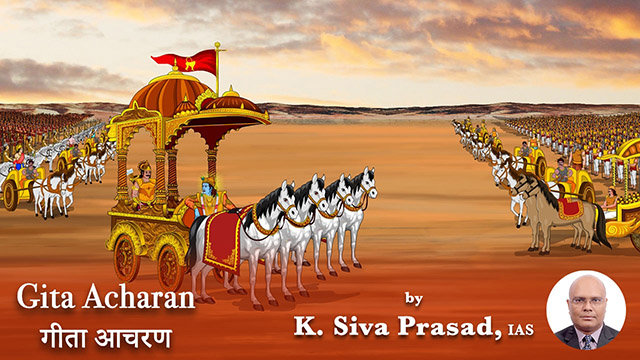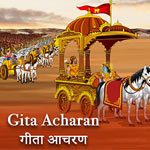
Understanding 𝙠𝙖𝙧𝙩𝙖 (doer) and 𝙠𝙖𝙧𝙢𝙖 (action) is one of the most complex issues of life. Bhagavad Gita explains about these complexities at various places. Krishna cautioned that even the wise are confounded about the subtleties of 𝙠𝙖𝙧𝙢𝙖 and 𝙖𝙠𝙖𝙧𝙢𝙖 (inaction or reaction) (4.16). Krishna explained that detachment or sacrifice of cosmic energy capable of creation (𝙗𝙝𝙪𝙩𝙖-𝙗𝙝𝙖𝙫𝙖-𝙪𝙙𝙗𝙝𝙖𝙫𝙖-𝙠𝙖𝙧𝙤 𝙫𝙞𝙨𝙖𝙧𝙜𝙖𝙝) is called 𝙠𝙖𝙧𝙢𝙖 (8.3) which is another complex issue. 𝙉𝙞𝙮𝙖𝙩 𝙠𝙖𝙧𝙢𝙖 (prescribed or obligatory action) is also an area of confusion. Krishna gave an easy path and advised to maintain inner balance while performing any 𝙠𝙖𝙧𝙢𝙖. He also advised the use of the sword of wisdom (4.41) to remove doubts about 𝙠𝙖𝙧𝙢𝙖.
After elaborating that 𝙠𝙖𝙧𝙢𝙖, 𝙠𝙖𝙧𝙩𝙖 and knowledge are of three types each based upon 𝙜𝙪𝙣𝙖𝙨, Krishna explains about 𝙠𝙖𝙧𝙢𝙖 and says, "A 𝙣𝙞𝙮𝙖𝙩 𝙠𝙖𝙧𝙢𝙖 (obligatory action) free from 𝙧𝙖𝙖𝙜 (attachment) and 𝙙𝙬𝙚𝙨𝙝 (aversion), and done without desire for fruits of action is called 𝙨𝙖𝙩𝙫𝙞𝙠 𝙠𝙖𝙧𝙢𝙖 (18.23). 𝙆𝙖𝙧𝙢𝙖 that is prompted by longing for satisfaction of desires, or performed with 𝙖𝙝𝙖𝙣𝙠𝙖𝙖𝙧 (egotism) and colossal effort, is declared as 𝙧𝙖𝙟𝙖𝙨𝙞𝙘 (18.24). 𝙆𝙖𝙧𝙢𝙖 which has begun out of delusion, without thought to one’s own ability, and disregarding consequences, loss, and injury to others, is declared as 𝙩𝙖𝙢𝙖𝙨𝙞𝙘" (18.25).
Krishna explains about 𝙠𝙖𝙧𝙩𝙖 and says, "The 𝙠𝙖𝙧𝙩𝙖 who is free from attachment and egotism, endowed with enthusiasm and determination, and equipoised in 𝙨𝙞𝙙𝙙𝙝𝙞-𝙖𝙨𝙞𝙙𝙙𝙝𝙞 (success and failure) is called 𝙨𝙖𝙩𝙫𝙞𝙠 (18.26). The 𝙠𝙖𝙧𝙩𝙖 who craves for the fruits of the action, covetous, cruel, impure, and moved by joy or sorrow is called 𝙧𝙖𝙟𝙖𝙨𝙞𝙠 (18.27). The 𝙠𝙖𝙧𝙩𝙖 who is undisciplined, vulgar, stubborn, deceitful, slothful, despondent, and a procrastinator is called 𝙩𝙖𝙢𝙖𝙨𝙞𝙘" (18.28).
Depending on the guna which is dominating us at a given point of time, the nature of 𝙠𝙖𝙧𝙢𝙖 and 𝙠𝙖𝙧𝙩𝙖 changes.
https://epaper.dailyworld.in/Details.aspx?id=147307&boxid=78144&uid=&dat=2024-09-29

